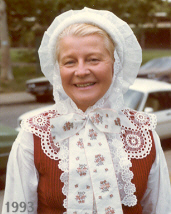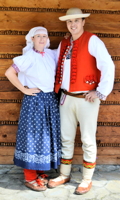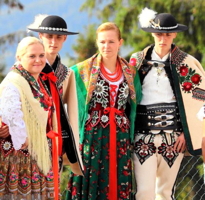
|
Folk Dance Federation of California, South, Inc.
|

|
CLICK AN IMAGE TO ENLARGE
 Silesia (Śląsk) is a province of Poland situated at her southwestern borders. To the south lies Czechoslovakia, and to the west lies Germany. As a result of this geographical location one can detect Moravian, Slovak, and German influences in the folklore of Silesia. The name Śląsk is derived from the name of the fiver and mountain Ślęża and the tribe that lived there in the early Middle Ages (tenth century) called the Ślężanie.
Silesia (Śląsk) is a province of Poland situated at her southwestern borders. To the south lies Czechoslovakia, and to the west lies Germany. As a result of this geographical location one can detect Moravian, Slovak, and German influences in the folklore of Silesia. The name Śląsk is derived from the name of the fiver and mountain Ślęża and the tribe that lived there in the early Middle Ages (tenth century) called the Ślężanie.
Poland lost Silesia at the beginning of the fourteenth century and regained it during the first part of the twentieth, so for 600 years, Silesia was outside of Poland, successively under Czech, Austrian, Prussian, and German rule. Despite this, Śląsk has remained basically Polish. Afraid to become denationalized, the Silesian people clung to their language, customs, and traditions.
From the geographic, historic, and ethnic point of view, Śląsk is divided into Lower Silesia (the northern part) and Upper Silesia (the southern part). This border was outlined in the early Middle Ages by a big belt of forests, the remnants of which still exist. The folklore of Lower Silesia is not pure in its Polish character. The reasons are: (1) Lower Silesia was industrialized already in the eighteenth century; (2) the German influence left a deep mark there; (3) after 1945, when it became a part of Poland again, in place of the departing German population it was settled by Poles from Eastern and Central Poland, who brought their different folklores with them.
The folk culture of Upper Silesia, on the other hand, is purer, more varied, and more interesting. Upper Silesia was industrialized later (second half of the nineteenth century) and, thanks to this, preserved more traditional customs, folk tales, songs, dances, and costumes. The emancipation of the peasants, which gave them both land and personal freedom, took place in the first half of the nineteenth century and was a conducive factor in the development of the folk culture.
 From the ethnographical point of view, Upper Silesia represents a very varied picture. The most striking people are the Beskidy mountaineers in the most southern part of the province, whose main occupation is shepherding. We find in their folklore the influence of the Wallachian shepherds who migrated from the Balkans and wandered throughout the Carpathian Mountains between the fourteenth and sixteenth centuries. Some settled in the Beskidy area. Further to the the north are the people living at the foot of the mountains, called the "Wałsi." Further down, on both sides of the Odra River, there are people whose main occupation is farming. A separate group are the coal miners (Silesia has one of the largest deposits of coal in Europe, and also copper, iron ore, and other minerals), who although recruited from all these groups, came to form a special stratum. Occasionally they wear their original folk costumes, made of black wool and ornamented with gold buttons and gold insignia, and a tall hat with white plumes on top.
From the ethnographical point of view, Upper Silesia represents a very varied picture. The most striking people are the Beskidy mountaineers in the most southern part of the province, whose main occupation is shepherding. We find in their folklore the influence of the Wallachian shepherds who migrated from the Balkans and wandered throughout the Carpathian Mountains between the fourteenth and sixteenth centuries. Some settled in the Beskidy area. Further to the the north are the people living at the foot of the mountains, called the "Wałsi." Further down, on both sides of the Odra River, there are people whose main occupation is farming. A separate group are the coal miners (Silesia has one of the largest deposits of coal in Europe, and also copper, iron ore, and other minerals), who although recruited from all these groups, came to form a special stratum. Occasionally they wear their original folk costumes, made of black wool and ornamented with gold buttons and gold insignia, and a tall hat with white plumes on top.
The Upper Silesian folk dances have preserved some archaic forms – for instance, a nine-measure phrase in the dance "Lipka" (little linden tree), or a seven-measure phrase in the dance "Diobołek" (little devil). The characteristic feature of the tunes is that they are composed of two, or sometimes even three parts, that differ in meter, tempo, and mood. Because of foreign influences, many dances have polka and waltz elements, but these rhythms have been adapted to create a special Polish style.
The dances are done in four ways: (1) by individual couples (for instance, "Od buczka do buczka," "Kozok," "Świniok"); or (2) by sets of couples ("Kaczok," "Kokotek"); or (3) by three people (Koziorajka," "Trojak" – the most popular dance, actually used all over Poland; or (4) by a whole group of people ("Bośkany" – flirting dance with a handkerchief, "Nie chcę cię znać" – a sort of mixer). The dances are sometimes remnants of ritual customs at weddings or harvest celebrations. Sometimes they imitate animals ("Zajączek" – little hare, or "Żabiok" – frog dance) or a profession (Kowol" – the blacksmith, "Szewc" – the cobbler) or are game dances (the above mentioned group dances plus "Mietlorz" – dance with an extra man dancing with a broom). The dances are often derived from a song and done with the singing.
The borderline dances of the region of the Beskidy Mountains form a special group. Because of political, cultural, and trade connections with their neighbors, one can see in these dances the influences of the Czech, Slovak, Moravian, and even Hungarian folklore. They are, however, not as complicated and as flashy as the dances of the Podhale mountaineers in the Tatras. The Beskidy folk orchestras contain unusual instruments that carry sound for long distances: the "gajdy" (bagpipe), the "trombita" (a very long shepherd horn, the end of which has to be supported by another man), and all kinds of "fujarka" and "piszczałka (pipe instruments).
The Silesian dances are still done, especially by older people, at weddings, christenings, after the big event of the year (taking out the sheep to pastures in the Spring), at harvest celebrations and other ceremonies, as well as at Sunday get-together parties (so called "muzyki"). Dancing also follows meetings of work commonly done (so called "pobaby"), like flaying of the feathers, treating of the flax, peeling of the beans, etc. Young people, however, tend to prefer contemporary dances. But the old folklore is being successfully preserved by numerous folk dance and singing groups and folk orchestras. The best known, but of course in a category of its own, is the Polish State Folk Ballet "Śląsk," created in 1953, that gave concerts all over Europe, the Americas, Asia, and Africa.
One of the outstanding authorities on the Silesian folklore, who has done thorough research in the field, is Janina Marcinowa, the choreographer of the Cieszyn Folk Ensemble, who published two excellent books: Folklor taneczny Beskidu Śląskiego, Warazawa, 1971, and with her daughter, Krystyna Sobczyńska, Folklor Górnego Śląska [Pieáni, taniec i obrzędy Górnego], Warszawa, 1973.
Excerpted from "Folklore of Polish Silesia,"
Ontario Folkdancer Newsletter, Vo1. 5, No. 6, June 1974.